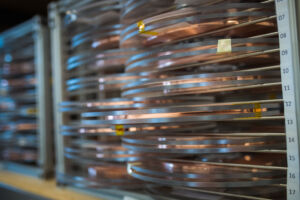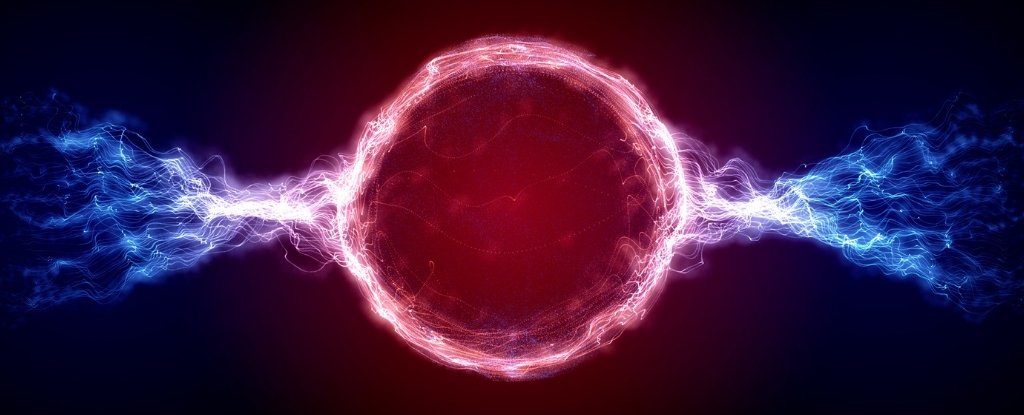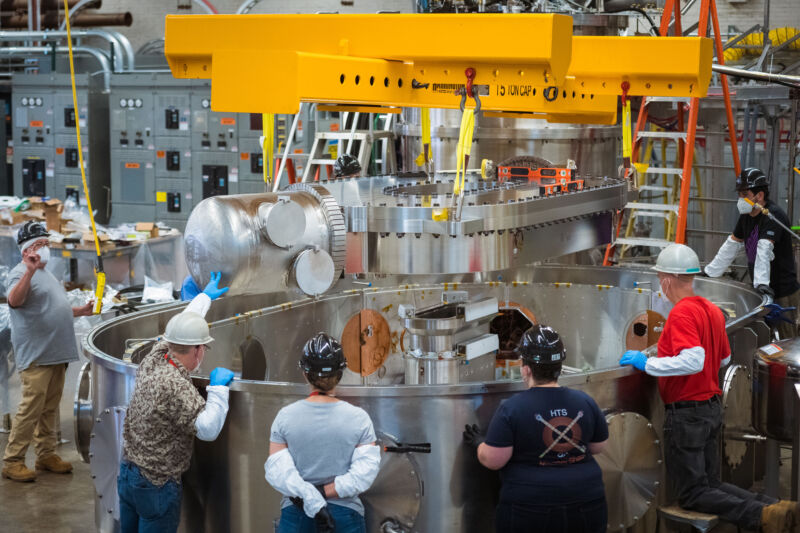In 2015, a group of physicists at MIT did some calculations to rethink how we're approaching the problem of fusion power. High-temperature, nonmetallic superconductors were finally commercially available and could allow the generation of stronger magnetic fields, enabling a simpler, more compact fusion reactor. But the physicists behind the work didn't stop when the calculating was done; instead, they formed a company, Commonwealth Fusion Systems, and set out to put their calculations to the test.
On Tuesday, Commonwealth Fusion Systems announced that it had hit a key milestone on its roadmap to having a demonstration fusion plant operating in 2025. The company used commercial high-temperature superconductors to build a three-meter-tall magnet that could operate stably at a 20-tesla magnetic field strength. This magnet is identical in design to the ones that will contain the plasma at the core of the company's planned reactor.
Aggressive roadmap
Giving yourself less than 10 years to solve a problem that an entire research field has been struggling with for decades is ambitious, but it reflects how relevant fusion could be to the climate crisis we're facing. Several of the company's leaders mentioned climate change as an inspiration for their work.
"The vision is simple: Can fusion energy be in time to make a difference to climate change?" said Dennis Whyte of MIT. "That's what everybody on this team was dedicated to going toward. Fusion is the energy source that the world needs, and it needs [it] kind of fast. And we're on the brink of harnessing that for humankind."
Waiting for decades to get to fusion will allow renewable power to expand its current cost advantage over all other forms of energy generation. And the time will give engineers opportunities to learn how to manage the challenges of the intermittency of wind and solar power. In this timeline, fusion risks being irrelevant by the time it's a solved problem.
That's why by 2025, Commonwealth Fusion Systems wants to have a reactor that will break even—i.e., a system in which fusion reactions release as much energy as is needed to start them. That milestone will be followed by what the company hopes will be a commercially viable fusion plant in the early 2030s. So fusion could be available by the time countries face the challenge of getting the last 10 percent of carbon emissions out of their power grids—something that is exceedingly challenging with intermittent renewables.
The roadmap has the potential to make fusion relevant, but that relevancy depends on hitting milestones on the way, which is where the magnet announcement comes in.
Magnets: they work
The magnet that was tested last week was about 10 meters tall and half that wide. It's powered by coils of a high-temperature superconducting material called ReBCO and operates at about 20 Kelvin. (In superconductivity, 20 K counts as high-temperature, as more typical superconducting materials need to be at less than 5 K.)
But the magnetic material is only part of the engineering challenge. It has to be held in place by a structure that can handle both extreme temperatures and extreme forces. Brian LaBombard, a researcher at Commonwealth Fusion Systems, described the problem at a press conference held on Tuesday. "When you push the magnets to the large size, you gotta think about the magnetic field as basically stored energy," LaBombard said. "When you pump up that magnetic field, as you have lots of energy inside the container—which is the magnet—it wants to push out against the magnet. It's basically like pressurizing a balloon, but it's magnetic-field strength."
Getting the whole structure up to 20 tesla involves a two-week process of cooling the structure and then gradually increasing the current circulating inside the superconductor. This process increases the magnetic field strength, but because it uses a superconductor, almost none of that current is lost. "Performance of this magnet is similar to a non-superconducting one that was used in an MIT experiment that concluded its experiments five years ago," said MIT's Whyte. "The difference in terms of energy consumption is rather stunning. That magnet, because it was a normal copper conducting magnet, consumed approximately 200 million watts of energy to produce the confining magnetic field. This magnet was around 30 watts, so a factor of around 10 million decrease in the amount of energy that was needed to provide the confining magnetic field."

The Commonwealth Fusion Systems magnet also faces challenges that one-off research reactors don't. It is designed for scaling to rapid production, which means a more modular design. The hardware is composed of a stack of thin coils, called pancakes, that each has its own sensors and control hardware. There's about 270 kilometers of superconducting material in the magnet, but it's distributed among all these individual pancakes.
What’s next?
Obviously, fusion requires much more than a functional magnet. But Commonwealth CEO Bob Mumgaard said the success with the magnet gives the team flexibility elsewhere.
"Because we've been able to go to very high magnetic field, we've relieved a lot of the constraints that push all those other aspects up against some really tough technical challenges," Mumgaard said. "We really pushed hard on the magnet side so that we could get some relief on these other types of issues."
And completing the magnet brought the company benefits in other ways. Joy Dunn, the company's head of operations, said, "It allowed us to develop the manufacturing processes and equipment and the supply chain at a scale that is relevant for commercial fusion." The expertise and processes involved in building this first test sample will be applied to develop more automated processes to manufacture the magnets that will go into future reactors. Dunn said that the later pancakes took only 20 percent of the time needed to make the first samples.
Assembling the system represents impressive progress and signals that Commonwealth Fusion Systems is likely to hit its milestone of putting together a fusion reactor over the next few years. The big question will be whether that reactor will achieve break-even fusion. All the calculations, which are informed by many years of experience with similar designs, indicate that the company will succeed.
But most fusion projects have run into surprises and require a period of learning before researchers get optimal performance out of the hardware. So even if those calculations are right, it may take a few years of testing before the break-even point is achieved, which might push the first commercial reactor deeper into the 2030s.
We may not be at the point where fusion is a decade away yet, but at least we're seeing some progress reports from a serious effort to get us there. And as Mumgaard summed things up, "That's a very, very hopeful story in an otherwise overwhelming new cycle on climate."



3175x175(CURRENT).thumb.jpg.b05acc060982b36f5891ba728e6d953c.jpg)


Recommended Comments
There are no comments to display.
Join the conversation
You can post now and register later. If you have an account, sign in now to post with your account.
Note: Your post will require moderator approval before it will be visible.